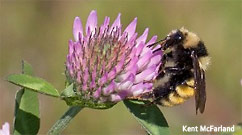The Troubling Buzz on Bees
From my colleagues at the Vermont Center for Ecostudies:

Northern Amber Bumblebee
More than one-quarter of Vermont’s bumble bee species, which are vital crop pollinators, have either vanished or are in serious decline, according to a new investigation from the Vermont Center for Ecostudies (VCE).
After conducting the most extensive search ever for bees across Vermont, VCE has concluded that three of the state’s 15 bumble bee species appear to have gone extinct and one more may not be far behind.
“We’re losing bumble bees even before we fully understand their benefits to our economy and well-being,” said Kent McFarland, senior conservation biologist at VCE, a wildlife research group based in Norwich.
Wild bees pollinate wildflowers and most crops in Vermont, including blueberries, tomatoes, squash and one of the state’s essential commodities: apples. Harmful parasites accidentally imported from Europe and a class of pesticides toxic to bees most likely account for the bumble bee declines.
From spring through fall of 2012 and 2013, VCE biologists and a corps of trained “citizen scientists” searched more than 1,500 locations across the state, amassing a database exceeding 10,000 individual encounters with bumble bees. Not once did they find rusty-patched bumble bee (Bombus affinis), which was fairly common in Vermont until the 1990s.
“This investigation confirms our fear that rusty-patched bumble bee is almost certainly extinct in Vermont and may never be back,” said McFarland. “We hardly knew it – and now it’s gone.”
Biologists across the continent are sounding alarms about bumble bee declines – a concern distinct from (but perhaps related to) the widespread collapse of honeybee colonies. VCE’s on-the-ground investigation, arguably the most extensive undertaken in any state, reveals that at least three other bumble bee species warrant concern:
- Ashton cuckoo bumble bee (Bombus ashtoni) infiltrates colonies of rusty-patched and yellow-banded bumble bees, enslaves the workers and uses them to feed its young. With the yellow-banded bumble bee severely depleted and the rusty-patched bumble bees now gone, so goes the invader.
- American bumble bee (Bombus pensylvanicus), once a common bumble bee in the Champlain Valley, has not been found since a University of Vermont student’s unwitting discovery in 2000.
- Yellow-banded bumble bee (Bombus terricola) had been feared to be on the brink of extinction in Vermont, but new encounters with this bumble bee during the VCE survey suggest it might be managing to survive some of the threats.

Tri-colored Bumblebee
VCE, which studies birds, insects, amphibians and other wildlife from Canada to South America, continues to examine its data to determine if additional bumble bee species warrant attention.
“Our next step is to move from investigation toward solutions,” said McFarland. “But those solutions will take hard work and partnerships among federal and state agencies and conservation research groups like ours.”
Trouble for bumble bees may have hitchhiked to the United States from Europe. To increase crop production, especially in greenhouse-grown tomatoes, farmers release common bumble bees into their greenhouses. Yet many of these native bee colonies were formerly raised in Europe, where they were infected with an intestinal parasite. When the infected bees were returned to North America for use in agriculture, probably in the 1990s, the European parasite spread among otherwise defenseless American bees.
Another culprit could be common pesticides, including a group known as neonicotinoids. “Neonicotinoid pesticides are particularly dangerous to bees because plants absorb them through the roots, rendering all plant parts toxic to insects,” said Leif Richardson, an entomologist at Dartmouth College and co-author of the upcoming Guide to Bumble Bees of North America. “This includes pollen and nectar, essential components of the bee diet.”
Habitat loss and urbanization are also taking their toll on pollinator populations of all kinds, bees included.
“Wild bees perform the majority of all pollination on Vermont farms, whether or not the managed European honey bee is present,” said Richardson. “As an ecosystem service, pollination is worth millions annually. But we don’t know how the loss of native bee species will affect our food supply or overall environmental health.”
The Vermont Center for Ecostudies (VCE) is a private, non-profit group of biologists uniting citizens and science for conservation. VCE’s research priorities include birds, insects, amphibians, and an ambitious effort to assess and map biodiversity. Based in Norwich, Vermont, VCE works across the hemisphere, from Canada to South America. www.vtecostudies.org.

As a beekeeper my concern keeps growing. Thank you for spreading the awareness.
How did you ever get that in-the-air picture of the tri-colored bumblebee? So cool!